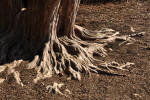|
 |
|
 |
|
 |
|
 |
 |
 This fungus is one of
many that help to rot away tree stumps and dead tree
roots. The problem comes when it decides to start
working on a live tree. Armillaria spreads by structures
called rhizomorphs which move out into the surrounding
soil from rotting stumps. If they come into contact with
the roots of nearby trees, they may penetrate into them
and start to rot them. This fungus is one of
many that help to rot away tree stumps and dead tree
roots. The problem comes when it decides to start
working on a live tree. Armillaria spreads by structures
called rhizomorphs which move out into the surrounding
soil from rotting stumps. If they come into contact with
the roots of nearby trees, they may penetrate into them
and start to rot them.

|
|
 |
 |
Trees infected with this
type of root rot lose vigor as they lose root mass.
Leaves may turn yellow and twigs and branches may die.
In severe cases, especially on smaller trees, the entire
plant may die in a relatively short period of time.
Also, live trees may be more subject to falling over in
wind or ice storms.
Other types of root rots
and factors may cause trees to have similar symptoms.
However, a tree infected with armillaria root rot will
have a dense, white mat of fungal tissue called a
mycelial fan growing between the bark and the wood of
the tree.

|
 |
 |
 There is no chemical
spray or drench that will control this rot. The only
approach is to try to keep the tree as healthy as
possible by proper pruning, occasional fertilization and
watering in drought, if possible. There is no chemical
spray or drench that will control this rot. The only
approach is to try to keep the tree as healthy as
possible by proper pruning, occasional fertilization and
watering in drought, if possible.

|
|
 |
|
Note: We
have provided some general information and
observations on this topic aimed at the home
gardener. Before you take
any serious action in your landscape, check
with your state's land grant university's
Cooperative
Extension
Service for the most current,
appropriate, localized recommendations. |
|
 |

|
|
Some plants resistant to armillaria root rot: |
|
|
 |



